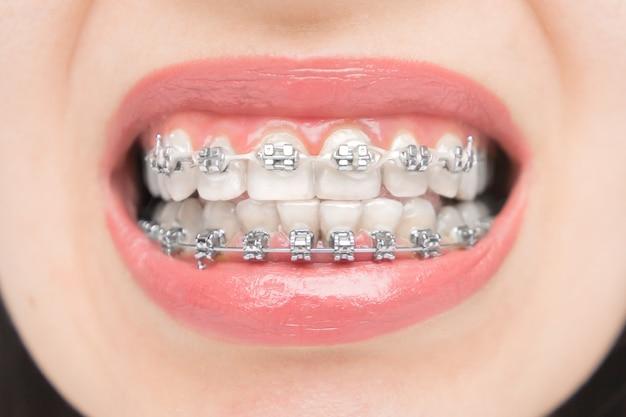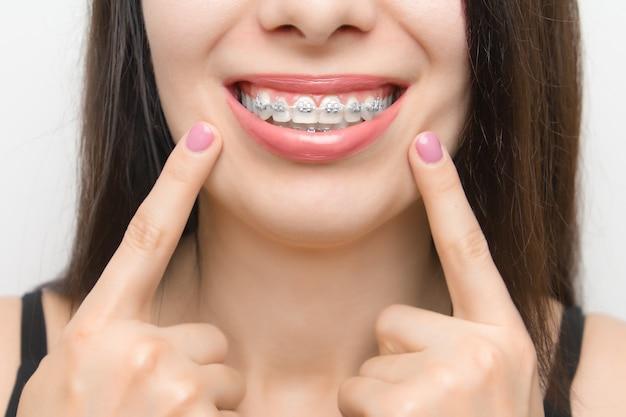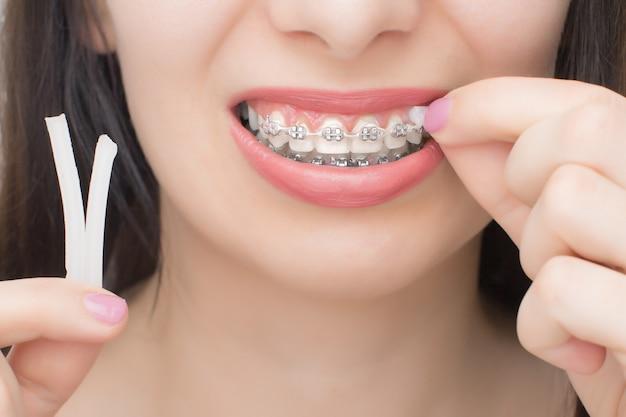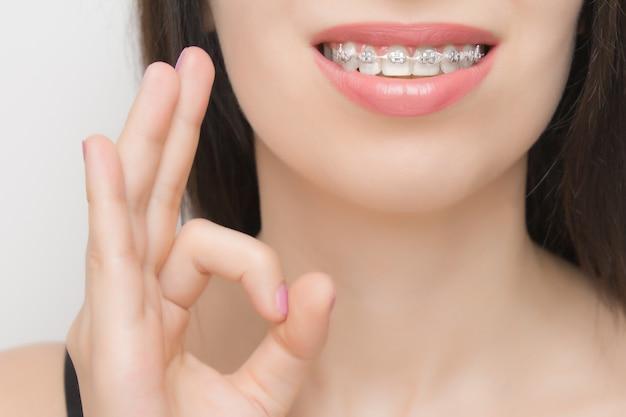Are you considering getting braces for yourself or your loved one? If so, you may have heard about metal self-ligating braces – a new and advanced type of braces that’s been gaining popularity in recent years.
In this comprehensive blog post, we’ll explore everything you need to know about metal self-ligating braces. From the basics of what they are and how they differ from traditional braces, to the pros and cons of self-ligating braces, and much more, you’ll find all the answers in here.
We’ll start by answering the most fundamental questions surrounding this topic. What are metal self-ligating braces, and how are they different from regular braces? Are they worth the investment, and how long do they typically last? Do they require rubber bands like the traditional braces?
We’ll also explore some of the common misconceptions and concerns regarding self-ligating braces, including their cost and the effectiveness compared to traditional braces. We’ll dive deep into the specifics of 3m self-ligating metal braces cost in India, giving you a comprehensive overview of the pricing and budgeting involved.
Whether you’re already considering getting self-ligating braces or just curious about them, this guide will provide you with the information you need to make an informed decision. So, sit back, relax, and let’s learn more about metal self-ligating braces and what makes them a popular choice for orthodontic treatment.
Understanding Metal Self-Ligating Braces
Metal self-ligating braces are a popular choice for people looking to get their teeth straightened. These braces are similar to traditional metal braces but come with an added advantage of a self-ligating mechanism. Unlike the traditional braces that use elastic ties to hold the archwire in place, self-ligating braces use a special clip that holds the wire securely in position. This clip eliminates the need for elastic ties, which means there’s less friction between the bracket and archwire.
Advantages of Metal Self-Ligating Braces:
Metal self-ligating braces have several advantages over traditional braces. Some of these advantages include:
-
Faster treatment time: Self-ligating braces can align teeth quicker than traditional braces, which means you’ll have fewer appointments with your orthodontist and a shorter overall treatment time.
-
Less discomfort: These braces cause less discomfort because they apply gentle, continuous pressure on the teeth. There’s no need for frequent, painful adjustments, which can be helpful, especially if you have a low pain tolerance.
-
Improved oral hygiene: With self-ligating metal braces, you don’t have to worry about elastic ties trapping food particles, which can contribute to plaque buildup. This makes it easier for you to clean your teeth and maintain good oral hygiene.
Choosing Between Traditional Metal Braces and Self-Ligating Braces:
When it comes to choosing between traditional metal braces and self-ligating braces, it’s essential to consult with your orthodontist to understand the differences between the two. While self-ligating braces offer several benefits, they may not be suitable for everyone. Your orthodontist will recommend the best option that suits your specific needs.
In conclusion, self-ligating metal braces can offer a faster, more comfortable, and efficient alternative to traditional metal braces. While they come at a slightly higher cost, the benefits are worth it. However, it’s always essential to consult with your orthodontist to understand which option is best for you.
Self-Ligating Braces vs Damon
When it comes to metal self-ligating braces, there is another popular option that you might come across during your research, and these are called Damon brackets. Here is a comparison of self-ligating braces vs Damon:
What are Damon Brackets
Damon Brackets are a type of self-ligating braces that use a slide mechanism to hold the archwire. Unlike traditional self-ligating braces, Damon Brackets use a passive slide mechanism. This means that the archwire can move freely within the brackets, allowing your teeth to move more naturally.
Benefits of Damon Brackets
One of the main benefits of Damon Brackets is that they require fewer adjustments than traditional self-ligating braces. This is because the brackets are designed to be more efficient, allowing your teeth to move more quickly and comfortably with fewer appointments needed.
Another advantage of Damon Brackets is that they are more discreet than traditional braces. This is because the brackets are made from clear or tooth-colored materials, making them less noticeable and a great option for patients who want to maintain a more natural appearance during their treatment.
Self-Ligating Braces Vs Damon
While both types of braces are effective in correcting orthodontic issues, there are some differences between self-ligating braces and Damon Brackets. For one, self-ligating braces offer more control over tooth movement, thanks to their active slide mechanism. This mechanism allows for more precise adjustments to be made to the archwire, resulting in more accurate tooth movement.
However, Damon Brackets offer more freedom of movement, which can reduce the amount of pressure on your teeth and overall discomfort during treatment. Additionally, as mentioned above, Damon Brackets require fewer adjustments, which can lead to faster treatment times and fewer appointments.
Ultimately, the choice between self-ligating braces and Damon Brackets will depend on your individual needs and preferences. It’s best to consult with an orthodontist to determine which option is right for you.
In conclusion, self-ligating braces vs Damon can be a tough choice, but both options offer their own unique benefits. If you are considering orthodontic treatment and want to learn more about these options, consult with an experienced orthodontist to determine which type of braces is best for you.
What Are Self Ligating Metal Braces
Metal self-ligating braces are very similar to traditional metal braces; however, they use a slightly different method to hold the wire in place. Self-ligating braces do not require bands or ties that traditional braces need. Instead, they use a small metal clip that opens and closes, holding the wire in place. As a result, self-ligating braces require fewer adjustments than traditional braces.
How Do They Work
Self-ligating braces use a wire that is designed to move your teeth gradually to their desired position. When the wire needs to be adjusted, your orthodontist will use the small clip on each bracket to release it. This allows the wire to slide freely through the brackets and reposition your teeth. Since there are no rubber bands or wires to re-tighten, you are less likely to experience pain or discomfort.
What Are the Advantages of Self-Ligating Braces
One of the biggest benefits of self-ligating braces is that they require fewer adjustments. This means that you will have fewer appointments with your orthodontist, and your treatment can be completed more quickly. Self-ligating braces can also straighten your teeth more efficiently than traditional braces. Additionally, because there are no elastic bands, self-ligating braces typically cause less irritation and require less maintenance.
Are Self-Ligating Braces Right for You
Self-ligating braces are a viable option for many people, but they may not be suitable for every case. In general, they are best for patients who need mild to moderate orthodontic treatment. Your orthodontist can assess your specific needs and recommend the best type of braces for you.
Overall, self-ligating braces are an effective and efficient way to straighten your teeth. If you are looking for a more comfortable and streamlined orthodontic treatment, talk to your orthodontist about self-ligating metal braces.
How Long Do Self-Ligating Braces Last
So, how long do self-ligating braces last on average? It’s a common question that many patients have when considering braces. The answer depends on various factors, including your age, the severity of your case, and how well you take care of your braces.
Factors Affecting the Lifespan of Self-Ligating Braces
Age
The age of the patient is an essential factor that can affect the lifespan of the braces. For young patients who are still growing, the treatment time may be longer as their jaws are still developing.
Severity of the Case
The severity of the case can also determine how long you need to wear braces. Patients with severe malocclusions or misalignments may require more extended treatment than those with milder cases.
Oral Hygiene
Good oral hygiene is crucial to the success of any orthodontic treatment. Patients who take excellent care of their teeth and braces are more likely to experience a shorter treatment time than those who don’t.
Average Treatment Time
On average, self-ligating braces treatment can last anywhere from 12 to 24 months. However, this time frame can vary depending on the factors mentioned above.
Maintaining Your Braces
Once your braces are removed, it’s essential to maintain your new smile properly. This includes wearing retainers as instructed and visiting your orthodontist for regular checkups.
In conclusion, self-ligating braces can last anywhere from 12 to 24 months, depending on various factors. With proper care and maintenance, you can help ensure a successful outcome and enjoy your new smile for years to come.
Do Self-Ligating Braces Need Rubber Bands
If you’re considering getting braces, you might be wondering about the different types of braces available. Self-ligating braces are a popular option, but do they need rubber bands? Let’s find out.
Understanding Self-Ligating Braces
Self-ligating braces are a type of braces that don’t require elastic or metal ties to hold the wire in place. Instead, they use a special clip or bracket mechanism that holds the wire in place.
The Role of Rubber Bands in Traditional Braces
In traditional braces, rubber bands are used to connect the brackets and apply pressure to the teeth. They are usually changed every few weeks as the teeth move.
Rubber Bands and Self-Ligating Braces
Self-ligating braces don’t require rubber bands to hold the wire in place, but they sometimes use them for additional pressure or to correct specific bite-related issues. However, not every patient with self-ligating braces needs rubber bands.
The Benefits of Self-Ligating Braces Without Rubber Bands
One of the main benefits of self-ligating braces without rubber bands is that they require fewer adjustments and maintenance appointments. This can be a big advantage for people with busy schedules who don’t want to spend too much time at the orthodontist.
The Importance of Consulting Your Orthodontist
Ultimately, whether or not you need rubber bands with your self-ligating braces depends on your individual needs and goals. It’s important to consult with your orthodontist to determine the best treatment plan for you.
Self-ligating braces are a great option for people looking for a more comfortable and low-maintenance orthodontic treatment. While rubber bands are sometimes used with these braces, they are not always necessary. Talk with your orthodontist to find out if self-ligating braces are the right choice for you.
The Cons of Self-Ligating Braces
When it comes to teeth straightening, there are a variety of options to choose from. One of these options is self-ligating braces. While self-ligating braces might seem like the perfect alternative to traditional braces, they do come with their fair share of cons that are worth considering before deciding on using them.
Higher Cost
Self-ligating braces are more expensive than traditional braces. While they have advantages over traditional braces, such as the fact that they require fewer appointments and less manipulation, the cost difference may be a significant drawback for some.
Not Suitable for Complex Cases
Self-ligating braces require less adjustment and manipulation than traditional braces, but they are not suitable for complex cases. They may not be the right choice for patients with significant crowding, crossbites, or skeletal malocclusions.
Less Visible Progress
One disadvantage of self-ligating braces is that they tend to show less visible progress than traditional braces. The lack of elastics and wires on self-ligating braces can make tracking progress more difficult, leading to less visible results.
Pain and Discomfort
Just like traditional braces, self-ligating braces can be painful and uncomfortable, especially after adjustments. Patients may experience sensitivity and difficulty chewing for a few days following appointments.
Longer Treatment Time
Compared to traditional braces, the treatment time for self-ligating braces may be longer. The difference might not be significant, but it’s still worth noting.
Maintenance
Even though self-ligating braces require fewer appointments, they still require care and maintenance. Patients still need to brush and floss regularly and avoid certain foods.
Self-ligating braces have many advantages over traditional braces, but they also have some disadvantages. Before you decide on using self-ligating braces, it’s essential to consider the drawbacks carefully, such as the higher cost, longer treatment time, and less visible progress. Discuss your options with your orthodontist to determine whether self-ligating braces are the best choice for you and your teeth.
Cost of 3M Self-Ligating Metal Braces in India
When considering getting braces in India, one of the primary concerns is the cost. 3M self-ligating metal braces are a popular option, but how much do they cost? In this section, we’ll explore the cost of 3M self-ligating metal braces in India.
Factors That Affect the Cost
There isn’t a fixed cost for braces, and several factors will influence the final price. For instance, the dentist’s experience, your location, the complexity of your case, and the materials used can all affect the cost. Typically, self-ligating braces are more expensive than traditional braces but offer added benefits for patients.
3M Self-Ligating Metal Braces
3M self-ligating metal braces are an excellent option for patients looking for a quicker treatment plan. In comparison to traditional braces, they have reduced friction and need fewer adjustments during appointments. Additionally, they have a smaller profile and are easier to clean, which reduces the likelihood of tooth decay.
Cost of 3M Self-Ligating Metal Braces
The cost of 3M self-ligating metal braces in India ranges from INR 30,000 to INR 80,000. Of course, this is just an estimate, and you should discuss your case with your dentist to get an accurate quote. Keep in mind that the price of brackets and wires is included in the overall cost. You may also need to budget for retainers, which are necessary after the braces are removed.
In summary, the cost of 3M self-ligating metal braces in India varies depending on several factors. It is best to have a consultation with your dentist to determine the final cost of treatment. While getting braces may seem expensive, it is a worthwhile investment in your dental health, and 3M self-ligating metal braces can make the treatment process more comfortable and more efficient.
Metal Braces vs. Self-Ligating Braces: Which One Is Better
Metal braces and self-ligating braces are two common orthodontic treatments used to correct a host of dental problems such as overcrowding, misalignment, and malocclusion. However, the question that many patients ask is, “which one is better: metal braces or self-ligating braces?” In this section, we will compare the two options to help you make an informed decision.
Metal braces
Metal braces are the traditional metal brackets and wires that we all recognize from TV shows and movies. They are still the most popular option because they are incredibly effective at straightening teeth. Metal braces are made from high-quality stainless steel and use a series of wires, brackets, and rubber bands to apply consistent pressure to the teeth, gradually shifting them into alignment.
Self-ligating braces
Self-ligating braces, on the other hand, are a relatively new innovation in orthodontics. They are similar to traditional metal braces but do not use rubber bands to secure the wire in place. Instead, they use a specialized clip or bracket that holds the wire in place, reducing friction, and allowing for more comfortable treatment.
Advantages of metal braces
Metal braces have been the gold standard in orthodontic treatment for decades, and they still have several advantages over self-ligating braces. Firstly, metal braces are more affordable than self-ligating braces, making them a popular option for patients on a tight budget. Secondly, they are highly effective at correcting even the most complicated dental issues, making them an excellent choice for patients with severe misalignment or malocclusion. Finally, metal braces are incredibly durable, and they rarely need any maintenance or repairs during treatment.
Advantages of self-ligating braces
Self-ligating braces also have several advantages over traditional metal braces. Firstly, they are more discreet than metal braces and are often favored by adults who do not want to wear metal brackets and wires. Secondly, self-ligating braces require fewer adjustments during treatment, reducing patient discomfort and the number of office visits needed. Finally, because there are no rubber bands to trap food particles, self-ligating braces are much easier to clean, reducing the risk of tooth decay and gum disease.
Ultimately, the choice between metal braces and self-ligating braces depends on several factors, including the patient’s age, budget, and the severity of their dental issues. Both options are highly effective at straightening teeth, and your orthodontist can help you choose the one that is best suited to your needs.



